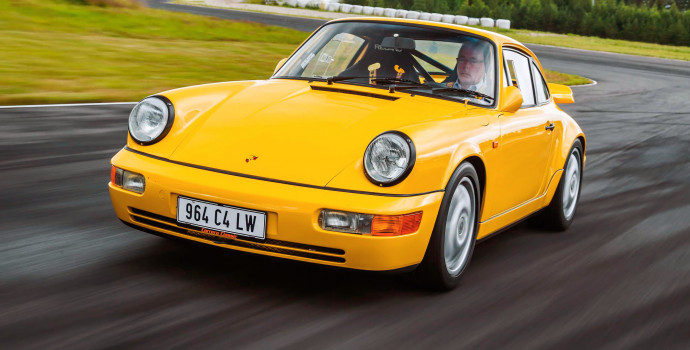Porsche 911 Carrera 4 Leichtbau (964) (1991)
Share
Unveiling the Porsche 911 Carrera 4 Leichtbau (964) (1991)

The Porsche 911 Carrera 4 Leichtbau (translated as "lightweight") represents a rare gem in the illustrious legacy of the Porsche 911 lineage. Launched in 1991, the Leichtbau variant of the 964 series was designed with the endurance racer in mind and perfectly balances performance, aesthetics, and the iconic Porsche driving experience.
A Brief History of the 964

The 964 series was introduced in 1989 as the fourth generation of the Porsche 911. It was the first 911 to feature a complete redesign from the earlier models, featuring a blend of modern technology with classic Porsche characteristics. Equipped with a 3.6-liter flat-six engine, the 964 offered better performance and efficiency while retaining the iconic body shape that enthusiasts adore. The Leichtbau variant took this a step further, focusing on performance by shedding weight without compromising on structural integrity or safety.
Design and Features

One of the most distinctive aspects of the Leichtbau design is its weight-saving features. With the use of lightweight materials like aluminum and carbon fiber, the Leichtbau reduces the overall weight of the car significantly compared to the standard Carrera 4 model. This focus on weight reduction allowed the car to exhibit sharper handling, increased agility, and quicker acceleration.
The design is further accentuated by its unique bodywork, including a more aggressive front bumper, wider rear fenders, and a retractable rear spoiler that enhances aerodynamics. The lower ride height coupled with the iconic 911 silhouette, provides an unmistakable presence on the road.

Inside, the Leichtbau edition features a spartan yet functional interior. Stripped down to essentials to save weight, it comes with lightweight bucket seats, minimalistic controls, and a refined cockpit that reflects Porsche's focus on driver engagement. Optional features included advanced audio systems and air conditioning but were often omitted to keep the car as light as possible.
Performance Specifications

Under the hood, the Porsche 911 Carrera 4 Leichtbau is powered by a robust 3.6-liter flat-six engine, generating an exhilarating 250 horsepower. Paired with a 5-speed manual transmission, this powerplant pushes the 964 from 0 to 60 mph in just under six seconds. The all-wheel-drive system enhances traction and stability, making it an extremely reliable performance car regardless of road conditions.
Moreover, thanks to its lightweight construction, the Leichtbau variant achieves excellent power-to-weight ratios, translating into thrilling performance. The precise steering, coupled with a finely tuned suspension system, results in a driving experience that promises excitement on both street and track.
Iconic Heritage
The 911 Carrera 4 Leichtbau (964) is more than just a car; it’s a representation of Porsche's commitment to innovation and performance. Limited in production, it quickly gained recognition among car enthusiasts and collectors. Today, the rarity and performance pedigree of the Leichtbau make it a highly sought-after model for collectors and Porsche aficionados alike.
Conclusion

The Porsche 911 Carrera 4 Leichtbau (964) of 1991 epitomizes the essence of Porsche—a stunning amalgamation of performance, design, and heritage that captures the heart of driving enthusiasts. Its lightweight construction, coupled with the raw power of its 3.6-liter engine, ensures that it delivers an unmatched driving experience.
While the world of automotive engineering continues to evolve, the essence of the Porsche 911 Carrera 4 Leichtbau remains timeless, proving that in the realm of sports cars, less can indeed be more. The Leichtbau serves as a reminder of Porsche's ingenious ability to merge tradition with innovation, securing its place in car culture for generations to come.